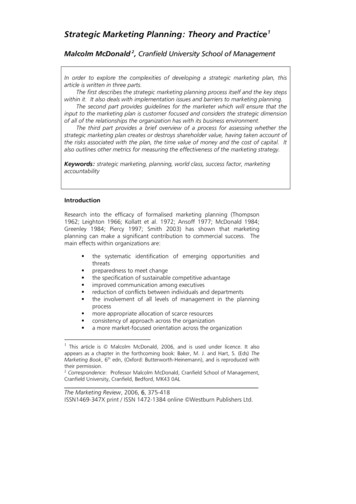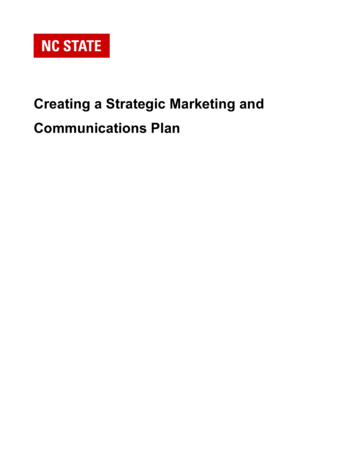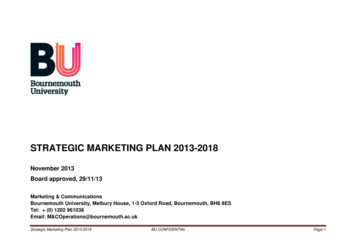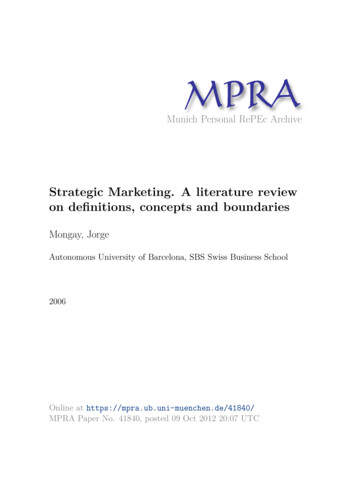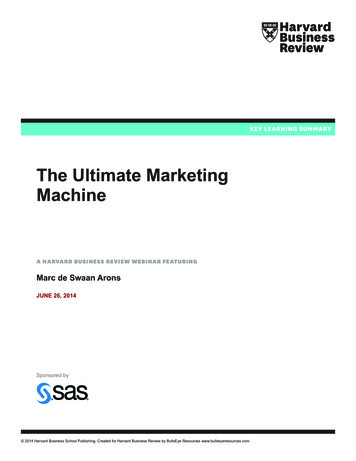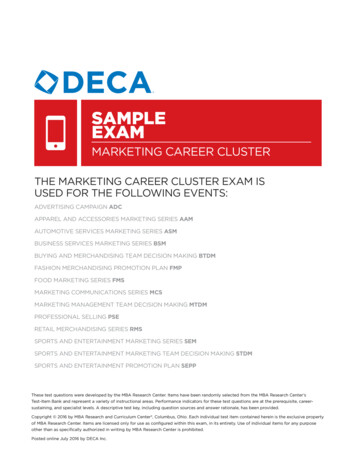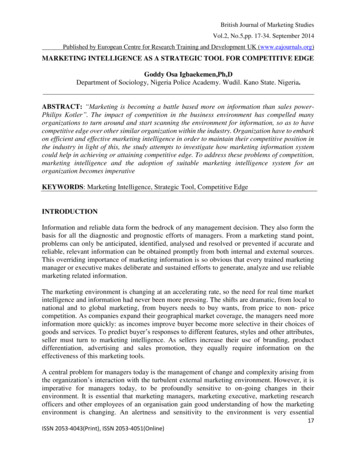
Transcription
British Journal of Marketing StudiesVol.2, No.5,pp. 17-34. September 2014Published by European Centre for Research Training and Development UK (www.eajournals.org)MARKETING INTELLIGENCE AS A STRATEGIC TOOL FOR COMPETITIVE EDGEGoddy Osa Igbaekemen,Ph,DDepartment of Sociology, Nigeria Police Academy. Wudil. Kano State. Nigeria.ABSTRACT: “Marketing is becoming a battle based more on information than sales powerPhilips Kotler”. The impact of competition in the business environment has compelled manyorganizations to turn around and start scanning the environment for information, so as to havecompetitive edge over other similar organization within the industry. Organization have to embarkon efficient and effective marketing intelligence in order to maintain their competitive position inthe industry in light of this, the study attempts to investigate how marketing information systemcould help in achieving or attaining competitive edge. To address these problems of competition,marketing intelligence and the adoption of suitable marketing intelligence system for anorganization becomes imperativeKEYWORDS: Marketing Intelligence, Strategic Tool, Competitive EdgeINTRODUCTIONInformation and reliable data form the bedrock of any management decision. They also form thebasis for all the diagnostic and prognostic efforts of managers. From a marketing stand point,problems can only be anticipated, identified, analysed and resolved or prevented if accurate andreliable, relevant information can be obtained promptly from both internal and external sources.This overriding importance of marketing information is so obvious that every trained marketingmanager or executive makes deliberate and sustained efforts to generate, analyze and use reliablemarketing related information.The marketing environment is changing at an accelerating rate, so the need for real time marketintelligence and information had never been more pressing. The shifts are dramatic, from local tonational and to global marketing, from buyers needs to buy wants, from price to non- pricecompetition. As companies expand their geographical market coverage, the managers need moreinformation more quickly: as incomes improve buyer become more selective in their choices ofgoods and services. To predict buyer’s responses to different features, styles and other attributes,seller must turn to marketing intelligence. As sellers increase their use of branding, productdifferentiation, advertising and sales promotion, they equally require information on theeffectiveness of this marketing tools.A central problem for managers today is the management of change and complexity arising fromthe organization’s interaction with the turbulent external marketing environment. However, it isimperative for managers today, to be profoundly sensitive to on-going changes in theirenvironment. It is essential that marketing managers, marketing executive, marketing researchofficers and other employees of an organisation gain good understanding of how the marketingenvironment is changing. An alertness and sensitivity to the environment is very essential17ISSN 2053-4043(Print), ISSN 2053-4051(Online)
British Journal of Marketing StudiesVol.2, No.5,pp. 17-34. September 2014Published by European Centre for Research Training and Development UK (www.eajournals.org)ingredient of business success, survival and longevity, because of the firm’s dependence on it forresources inputs and services outputs.Successful companies take an outside-inside view of their business. They recognize that marketingenvironment is constantly presenting new opportunities and threats, which can only be detected,collected, analysed and utilized through the use of marketing intelligence and likewise anorganisation should understand the importance of continuously monitoring and adapting to thatenvironment. Many organisations fail to see change as opportunity. They ignore or resist changesuntil is too late. Their strategies, structures, systems and organizational cultures grow increasinglyobsolete and dysfunctional.The need for marketing information as regards the marketing environment of an organisationcannot be over emphasized that is why this research work is highly imperative to today’s decisionmaking, the survival, the success and sustainability of an organisation. Moreover, a betterunderstanding marketing intelligence requires the understanding of concept marketing informationsystem. (This is analysed under the literature review). However, marketing information systems,marketing intelligence systems and marketing research systems are used to gather and analyse datafor various parts of marketing plan. These systems can help marketers examine changes and trendsto markets, competition, consumer needs, product usage and distribution channels, among otherareas. They can turn up evidence of importance opportunities and threats that must be addressed.Incarrying out marketing intelligence a manager or marketers needs to scan its environment foruseful relevant and up-to-date information about all marketing activities in terms of opportunitiesand threats in this regard in this section of background of the study I tried in analyzing whatenvironmental scanning is all about while in the later chapters , I will discuss more fully on theissue of marketing intelligence and marketing information system.The term environment scanning is often used inter- changeably with others such as environmentanalysis, competitive intelligence gathering and strategic marketing information. In this respect, itcould be regarded as marketing intelligence though there is difference however; they both servethe same major function in the marketing environment.Environmental scanning is a process bywhich marketing managers and executives probe and monitor the business environment todetermine the opportunities for and threats to the organisation. This is also a means through whichmanagers perceive and events in the marketing environment. The effectiveness of planning in anyorganisation is found to be directly related to the capacity of management for environmentscanning.1.2.3.4.5.As an organisation increases in size and complexity the need for marketing intelligence alsoincreases simultaneously. When addressing the issue of marketing intelligence certain questionsneeded to be addressed:What environment do firms need to scan or probe?What information in the environment does the firm need to gather?What are those necessary, relevant and up-to-date consumers need and want (in terms ofinformation do we need to have as an organisation?Of what relevance is this information?What techniques are available to marketing executives or managers for scanning?18ISSN 2053-4043(Print), ISSN 2053-4051(Online)
British Journal of Marketing StudiesVol.2, No.5,pp. 17-34. September 2014Published by European Centre for Research Training and Development UK (www.eajournals.org)a.b.c.d.e.f.g.The above questions coupled with the following questions, make the marketing intelligenceindispensable in the modern market.What kinds of people buy our product?What do they value?What do the buy?What kind of new product would they like to see in the market?Why the sudden change in consumers buying patterns?What if our competitors are attracting more consumers and why?What would be the effect of changes in the price of our product?These and other related questions are the key to informed marketing decision making. As wealready know that a prerequisite for the adoption of a marketing orientation is knowledge aboutconsumers and other aspect of the marketing environment that affect organisations operation’smanagers obtain information by informal and formal means. Casual discussion with customers atexhibitions or through sales calls can provide valuable informal information about theirrequirement, competitors activities and future happening in the industry. Some companiesparticularly those who have few customers, rely on these types of interaction gathering to keepabreast of market changes.As the customer base grows, such method may be inadequate to provide the necessary indepthmarketing knowledge to compete effectively. A more formal approach is needed to supplyinformation systematically to mangers. The research work focus on this formal method ofinformation provision.Marketing intelligence is important since the quality of the marketinginformation affect the effectiveness of decision making Irrespective of the sector of the economyor market an organisation operates, there is always a rivalry among the various player (theorganisations) in this sector, and each organisation need to device means of existing, sustainingand becoming a mega force to be reckoned with in this sector. Many organisations believe in theuse of price as a strategic tool in their various competitive market environment, however, one thingthat must be understood is that whether or not an organisation engages in price or non – pricecompetitions to have competitive advantage over others. It is still precipitated to good use ofmarketing intelligence, the monitoring of marketing activities for vital and essential information.Many factors have increased the need for more and better information as companies becomesnational and international in scope, they need more information on larger, more distant markets asincome increase and buyers becomes more selective organisation need better information abouthow buyers respond to their different products and appeals. As organisation uses morecompetition, they need information on the effectiveness of their marketing strategic tools. Intoday’s rapidly changing environment managers need up-to-date information to make timelydecision.REVIEW OF RELATED LITERATURENeisbitt (1999) suggests that the world is undergoing a “mega shift” from an industrial to aninformation based economy. He found that more than 65 percent of the US workforce now worksat producing or processing information compared to only 17 percent in 1950 using improvedcomputer systems and the other technologies, companies can now provide information in greater19ISSN 2053-4043(Print), ISSN 2053-4051(Online)
British Journal of Marketing StudiesVol.2, No.5,pp. 17-34. September 2014Published by European Centre for Research Training and Development UK (www.eajournals.org)quantities. His study revealed that with companies offering all the information now availablethrough the super mark scanners, a brand manager gets one million to one billion new memberseach week. As Neisbitt points out: “Running out of information is not a problem, but drowning init is”.Marketers frequently complain that they lack enough information of the right kind or havetoo much of the wrong kind.Regarding the spread of information through out the company, they say that it takes great effortsto located even simple facts. Subordinates may withhold information that they believe will reflectbadly on their performance. Often, important information arrives too late to be useful, or on- timeinformation is not accurate. Companies have greater capacity to provide managers withinformation, but have often not made good use of it. Many companies are now studying theirmanagers’ information need and designing information system to meet those needs.Despite theirearly success, Black and Decker continue to listen to its customers within a few months of thequantum introduction, the company held a three – day phonation to gather the thoughts of 2,500customers concerning then new quantum tools. As fortune Magazine (May 1, 1995, 121 -126)reported, Nearly 200 employees – assembly – line workers, marketing executives and everyonein between – flew from around the world to the company headquarter in Towson, Maryland, wherethe cafeteria had been set up with phone Banks, computers and in the word of quantum ProgramManager Clifford Hall, lots of Pizza” says he, “we want everyone associated with quantum here,what the consumer has to say” all of this marketing intelligence appears to be paying offhandsomely. According to one industry analyst, “Black and Decker has become very good attaking market share away from rival companies. They just know their customers’.In order to produce superior value, satisfaction for customers and to earn competitive edge,companies need information at almost every turn. Vi point Pharmaceuticals, a first Collins,Colorado, marketers of oral hygiene products grew from start –up sales of 13,000 to 37millionin 10 years. The company credits its success to it relationships with its customers both consumersand dentists which the compilation of individual information files, helped to establish. Similarly,relationship marketing has been strengthen for the Bank of A levy, of ventures California, by itsimplementation of a system that catalogs and sort marketing customer files. Manipulation ofindividual customer files through some database marketing program is becoming increasinglyimportant to relationship marketing. (Source: Business week, June 1997).Glaxo incorporation, a pharmaceutical maker in Research Triangle Park, North Carolina, spendsabout 2million a year on its sales and marketing decision support system for hardware, software,user training and personnel. Donald Rao, manager of marketing analysis and decision support atGlaxo, claims a return on investment of 1,000 percentages since the systems development in 1987.The system provides detailed data on physician locations within sales territories which allowmanagers to fine – tune marketing plans and product sample allocations. In addition it allowssubstantial savings in managerial time.Competitive intelligence gathering has grown dramatically as more and more companies are nowbusily snooping on their competitors. A recent survey of button line magazine (2001 edition), 250companies found that 80 percent had some type of business intelligence strategy in place.Techniques range from quizzing the company’s own employees and bench marking competitor’s20ISSN 2053-4043(Print), ISSN 2053-4051(Online)
British Journal of Marketing StudiesVol.2, No.5,pp. 17-34. September 2014Published by European Centre for Research Training and Development UK (www.eajournals.org)product to surfing the internet, lurking around industry trade show and roofing through rival’s trash– bins.According to the chief of corporative intelligence for Ryder system, Inc (1995), “Eight percent ofwhat you need to know can be found by talking to your own employees”. Here is an example ofhow listening to its own people paid off for Xerox. In early 1995, a Kodak copier salesman toXerox technician that he was being trained to service Xerox products. The Xerox employee toldhis boss who passed the new to the intelligence unit. Using such clues as a classified advert, Kodakplace seeking new people with Xerox product experience; they verified Kodak’s plan – codenamed Ulysses to service Xerox copiers”. The warning allow Xerox to device a scheme to (Protectits profitable service business through its) total satisfaction guarantee, which allow copier returnsfor any reason s long as Xerox did the servicing. By (the time) Kodak launched its plan Xerox hadbeen trumpeting its (programs) for three months.Companies can get to know competitors better bybuying their products or examining other physical evidence. For example, to design the first Taurusmodels, Ford compiled a list of more than 400 features its customers said they liked bet aboutcompeting cars. Then, it matched or topped the best of the competition. The result Taurus soonbecame America’s bestselling cars.According to fortune magazine (May 14, 1984, 29-33) on the article titled “ How to snoop on yourcompetitors”, the growing use of marketing intelligence raises a number of ethical issues.Theinternet provides quick and inexpensive access to a rich assortment of intelligence information. Bysimply checking competitors’ website, a company can gain important details concerning rival’sproducts, prices, promotional campaign and overall marketing strategies. Using internet searchengines such as yahoo or info seek; marketers can search specific competitors’ names, events ortrends and see what turns up. One website (www.fuld.com) even provides a competitiveintelligence guide offering sleuthing tips.MARKETING INTELLIGENCE SYSTEM: AN OVERVIEWTo augment the literature review, analysis of what marketing information system, marketingintelligence, market research, competitors marketing advantage and environment are emphasizedcoupled with other related work on these concepts.MARKETING INFORMATION SYSTEMIn any organization, marketing occupies an important role in its organizational set –up. Its purposeis centered on fulfilling the critical function of integrating the organization with the society. Theapplication of marketing information system was mention for the first time in marketing researchdepartment around 1910 in United States of America. A market oriented firm needs to haveknowledge of the people and market that it is operating with.Philip Kottler (2001) in his book“Marketing Management Implementation Analysis and Control” approach marketing informationsystem through a continuing and interacting structure of people, equipment and procedure used togather, sort, analyze and disseminate pertinent timely, and accurate information for use bymarketing planning, implementation control. Marketing information system can be described as aformal effort by management to systematize the flow of information needed by a marketer so that21ISSN 2053-4043(Print), ISSN 2053-4051(Online)
British Journal of Marketing StudiesVol.2, No.5,pp. 17-34. September 2014Published by European Centre for Research Training and Development UK (www.eajournals.org)marketing will be more available and useful to him. There are arguments that marketinginformation system is a structured, interacting complex of person(s), machine and proceduresdesigned to generate an orderly flow of information sources for use as input to marketing decisionmakers.Marketing information system could equally be seen as an open system encompassing certain typesof major information flows within a business organization and its environment. Marketinginformation is defined as marketing information system as an orderly procedure for the regularcollection of raw data both internally and externally and the conversion of these data intoinformation for decisions. Marketing information system is seen as a process applied within a largecompany, senior management with devotes considerable time and financial resources to realizethat not only do people materials plants and money needs to be managed, but also does information.Marketing information system seems to have been pioneered by Charles C. Parlin who started amarketing research department around 1910 in Curtis publishing company, and then theadvertising space could be sold more effectively by presenting organized market data toprospective advertising buyers.Agbonifoh (1998), marketing information system may be define as “a set of procedures andmethod for the regular planned collection, analysed and presentation of information for use inmaking marketing decision. The value of marketing information system, for any marketingorganization to succeed, it needs a regular supply of current and relevant information for marketingdecision- making. In order to be useful such information must be regular, timely, relevant andaccurate.The operation of a marketing information system involves huge financial outlays.Therefore, a cost benefit analysis is relevant. Information should not be gathered, just because theyare requested by decision makers. It is necessary to ensure that they are likely to help improve thequality of decision made and that information. Although the benefits of the information are noteasy to assess such benefits would most certainly be related to:a.b.c.the ability of the information to reduce uncertaintyThe magnitude of uncertainty, in the decision situationThe magnitude of the economic results of the decisionIn designing a marketing information system due regard must be paid to the informationrequirement of managers.Information need tend to be differing from company to company, andfrom industry to industry because different companies and different types of customers, areaffected by different environmental variables and are subject to different kinds and levels ofcompetition. Even companies in the same line of business may differ in their need for informationbecause of differences in internal factors and mode of operation:It is certainly very difficult to discuss all the frequently needed information but generally, they fallunder two categories internal and external. Some of the frequently needed items of informationare:1.Sales Data for the company as well as its competitors. Sales analysis on the basis of distributors,territories, and customer groups are important in sales forecasting. Breakdowns by products lines,22ISSN 2053-4043(Print), ISSN 2053-4051(Online)
British Journal of Marketing StudiesVol.2, No.5,pp. 17-34. September 2014Published by European Centre for Research Training and Development UK (www.eajournals.org)months or quarter and by brands are also useful. Sales reports enable the company to measure itsmarket share, market position and to determine its sales potential for the future.Cost Data: These are also needed for planning and control. Profit margins cannot be measurewithout cost data which include both production and marketing costs.Market Data: Marketing Information such as competitors, actions, consumer complaints productsperformance, market share information and demand and supply situation are important so also are,market responses to price, product and promotional changes.Customer Behaviour Data: Consumer behaviour is a major concern of every business organization.Every organization wants to know who his present and potential customers are. Why, when, whatand how often they buy as well as their buying intention. Also the distribution of its customer byage, social class, occupation, sex, marital status, life style and usage rage is extremely useful.Some firms have developed marketing information systems that provide management with rapidand incredible details about buyer wants, preferences and behaviour. For instance, the coca-colacompany knows that we put 3.2 ice cubes in a glass, see of its commercial every year, and prefercans to pop out of vending machines at a temperature of 35 degree. Kimberly- Clark, which makesKleenex, has calculated that we spend about 35 minutes each week vacuuming sucking up about8 pounds of dust each year and using 6 bags to do so.Marketing also have extensive informationabout consumption patterns in other countries. On a per capital basis within Western Europe, forexample, the Swiss consume the chocolate, the Greeks eat the most cheeses, the Irish drink themost tea and the Austrian smoke the most cigarettes.2.3.4.Nevertheless, many business firm lack information sophistication, many lack a marketing researchdepartment. Other has departments that limit work to routine forecasting, sales analysis andoccasional surveys. In addition, many managers complain about not knowing where criticalinformation is located in the company, getting too much information too late and doubting theinformation’s accuracy in today’s information enjoy a competitive advantage. The company canchoose its markets better, develop better offering, and execute better marketing planning.Everyfirm must organize and distribute a continuous flow of information to its marketing managers.Companies study their managers, information needs and design Marketing Information System(MIS) to meet these needs. A company’s marketing information system should represent a crossbetween what manager’s think they need, what managers really need and what is economicallyfeasible. An interval MIS committee can interview a cross section of marketing managers todiscover their information needs. Some used questions are; What decision do you regularly make?What information do you need to make these decisions?What information do you regularly get?What special studies do you periodically request?What information do you want that you are not getting now?What information would you want daily? Weekly? Monthly? Yearly?What magazines and trade reports would you like to see on a regular basis?What data analysis programme would you want?What topic would you like to keep informed of?What are the four most useful improvements that could be made in the present marketinginformation system?23ISSN 2053-4043(Print), ISSN 2053-4051(Online)
British Journal of Marketing StudiesVol.2, No.5,pp. 17-34. September 2014Published by European Centre for Research Training and Development UK (www.eajournals.org)THE STRUCTURE OF MARKETING INFORMATION SYSTEMIn order for marketing information system to function properly, the structure of the system mustbe clearly understood by the user. According to Kottler (2003), a marketing information system isdeveloped from medical record system, marketing intelligence, marketing research system andmarketing decision support analysis.Internal Record System: The most basic information system used by marketing executives is theinternal reports system. This system records sales, order, stock, prices, cost, inventory levels,receivables, payables and basic financial information. By analyzing this information marketingmanagers can spot important opportunities and problems.Marketing Intelligence System: This can be described as the set of procedures and sources usedby managers to obtain everyday information about pertinent developments in the marketingenvironment. These facts about the development in the environment are disseminated to theexecutives to be used as a basis for marketing decision.Marketing Research System: This is the systematic design, collection, analysis and reporting ofdata and findings relevant to a specific marketing situation facing the company. This system comesout as a specific study of a situation so as to promote enough information, which will help themarketing manager to make intelligence decision about the situation.Marketing Decision Support Analysis: Marketing decision support system is a co-ordinatedcollection of data, systems, tools and techniques with supporting software and hardware by whichan organisation gathers and interprete relevant information form business and environment andturns it into a basis for marketing actions.Marketing Intelligence System (MIS)Marketing intelligence is everyday information about development in the marketing environmentthat helps managers prepare and adjust marketing plans. The marketing intelligence systemdetermines the intelligence needed, collect it by searching the environment and delivers it tomarketing manager who need it. Marketing intelligence comes from many sources muchintelligence is from the company’s personnel executives, engineers and scientist, purchasingagents and the sales force. But company people are often busy and fail to pass on importantFunction. The Company must “sell” its people on their importance as intelligence gathers, fromthem to spot new development and urge them to report intelligence back to the organisation.Companies also buy intelligence information form out side supplies. Dun and Bradstreet is theworld’s largest research company with branches in 40 countries and a turnover of 1.26 billion.Its largest subsidiary is Nielsen which sells data on brand shares, retail prices and percentage ofstores stocking different brands. Its info Act workstation offers companies the chance to analysedata from three sources on the PC’s retail index, which monitor consumer panel. Alliance betweenmarketing research companies allow access to pan-European Research. Other big internationalresearch companies are WPP, Nelson, which owns AGB, GFK, MAL, which owns NOP, andinfratest.24ISSN 2053-4043(Print), ISSN 2053-4051(Online)
British Journal of Marketing StudiesVol.2, No.5,pp. 17-34. September 2014Published by European Centre for Research Training and Development UK (www.eajournals.org)Marketing intelligence can work not only for, but also against company. Companies mustsometime take steps to protect themselves form the snooping of competitors. For exampleKellogg’s had treated the public to tours of its plants since 1906, but recently closed its newlyupgraded plant to outsiders to prevent competitors from getting intelligence on its high- techequipment. In Japan Corporate intelligence is part of the Industrial culture. Every one fromassembly – line – workers to top executives considers it their duty to filter intelligence about thecompetition back to management. Western companies are less active, although most of America’sfortunes 500 now have in- house corporate intelligence units. Businesses are becomingincreasingly aware of the need both to gather information and to protect what they have somecompanies set –up an office to collect and circulate marketing intelligence. The staff scans relevantpublications, summaries important news and sends news,bulletins to marketing managers. Theydevelop a file of intelligence information and help managers to evaluate new information.DATA BASE MARKETINGAny aspect of marketing intelligence is database marketing. A significant technological innovationis database marketing, the collection and use of individual customer- specific information to makemarketing more efficient. The term data base refers to customers’ prospect information stored in acomputer with software to process the information. Computer technology provides the ability topull apart and recombine information in ways previously impossible knowing which customersare more predisposed to which products allow a firm to fails or marketing efforts to individualcustomers and this is one of the objectives of marketing intelligence. Development in informationtechnology
British Journal of Marketing Studies Vol.2, No.5,pp. 17-34. September 2014 Published by European Centre for Research Training and Development UK (www.eajournals.org) 17 ISSN 2053-4043(Print), ISSN 2053-4051(Online) MARKETING INTELLIGENCE AS A STRA

